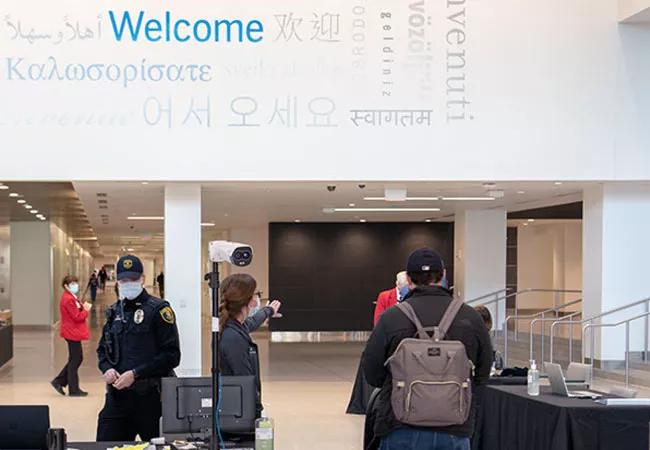Screening automation is safe and efficient

Temperature checks at all entrances of Cleveland Clinic locations are the new normal today for all patients, visitors and employee caregivers.
Cleveland Clinic is a non-profit academic medical center. Advertising on our site helps support our mission. We do not endorse non-Cleveland Clinic products or services. Policy
In May, Cleveland Clinic Protective Services installed thermal cameras at 35+ entrances across its Cleveland, Ohio locations. This technology works by measuring the infrared radiation, or heat, that a person emits.
The cameras screen all people upon entry into buildings, with a threshold temperature of 100.4 F. When this temperature or higher is detected, a caregiver/screener instructs the person to step out of line, sanitize their hands, put on a mask and gloves, and contact their primary care provider. They are also provided information on how to schedule a virtual visit with a physician for further examination. Employee caregivers who have a temperature at or above 100.4 F are instructed to call Cleveland Clinic’s Occupational Health hotline, notify their managers and return home immediately.
“We are following the CDC’s recommendations to screen caregivers, patients and visitors upon entering our Northeast Ohio locations,” says Gordon Snow, Cleveland Clinic’s Chief Security Officer. “Thermal scanning offers a noncontact, automatic, multi-person temperature measurement, while ensuring social distancing.”
Research has shown that, when used correctly, these no-contact thermometers are just as accurate as oral or rectal thermometers. “No-contact thermometers are popular among pediatricians, as kids often squirm around when trying to get a temperature read, but it also holds true in mass temperature screenings,” says Family Medicine specialist Neha Vyas, MD. “The device offers safety to both parties while providing a quick and accurate read.”
Prior to patients’ arrival for appointments, they are reminded to allow extra time for COVID-19-related screening at our entrances. As they enter a Cleveland Clinic location, the thermal cameras take their temperatures as they stop to report if they are exhibiting other symptoms of COVID-19, such as a cough or headache, and signage directs people to maintain at least a six-foot distance between screeners and all arriving visitors.
“We are finding that thermoscanning is generally accepted and appreciated by caregivers, patients and visitors alike,” says Snow. “We want people in the community to understand that these precautions are an important signal of our commitment to safety for all.”
Snow notes that the COVID-19 pandemic requires multiple layers of protection to keep Cleveland Clinic facilities safe, including the use of face covers, safe distancing, reducing density of people in buildings, and rigorous cleaning and disinfecting.
“While no single method is 100% effective at stopping the spread of COVID-19, a layered defense in depth, when used together consistently, helps offset the weaknesses in any single layer of protection,” Snow explains.
Thermoscan cameras are also being installed at Cleveland Clinic locations in Florida and Abu Dhabi.

Patients report improved sense of smell and taste

Clinicians who are accustomed to uncertainty can do well by patients

Unique skin changes can occur after infection or vaccine

Cleveland Clinic analysis suggests that obtaining care for the virus might reveal a previously undiagnosed condition

As the pandemic evolves, rheumatologists must continue to be mindful of most vulnerable patients

Early results suggest positive outcomes from COVID-19 PrEP treatment

Could the virus have caused the condition or triggered previously undiagnosed disease?

Five categories of cutaneous abnormalities are associated with COVID-19